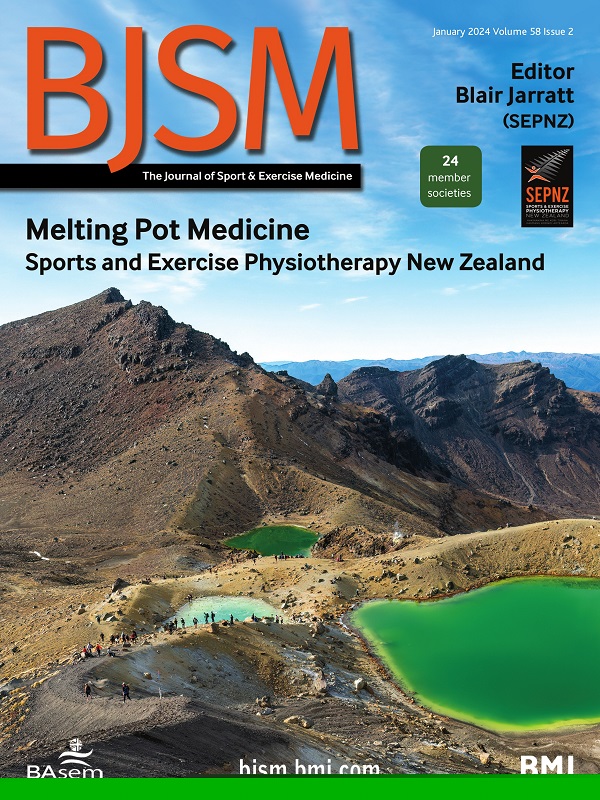脑震荡和功能性神经障碍的连续性的新框架
IF 11.6
1区 医学
Q1 SPORT SCIENCES
引用次数: 0
摘要
在过去的20年里,科学调查和公众对脑震荡的认识呈指数级增长。这代表了这一领域的重大转变,而这一领域以前在某种程度上被医疗机构、研究资助者和卫生政策制定者所忽视。尽管在更好地识别和管理急性脑震荡方面取得了实质性进展,但仍存在许多知识空白目前最大的难题之一是15%-30%的患者经历持续数月至数年的脑震荡后症状(PPCS)。这篇社论探讨了如何更好地理解脑震荡/PPCS与功能性神经障碍(FND)之间的连续性,从而推进脑震荡的护理和研究。与此同时,对FND(以前称为转换障碍)的理解也在不断发展。FND可以定义为与传统神经系统疾病不相容的不自主神经症状的存在这可以比作大脑回路的“软件”(功能)问题,而不是神经系统的“硬件”(结构)疾病。FND是非自愿的,不应与装病混为一谈(故意制造或夸大症状以获取外部利益,例如经济补偿)。FND症状亚型包括功能性运动障碍、功能性麻痹、功能性癫痫发作、功能性感觉障碍、功能性认知障碍和功能性头晕(也称为持续性体位知觉头晕(PPPD))。后两种表型与围绕PPCS的考虑特别相关。最近FND研究的重点是从排除性诊断转向纳入基于内部不一致、注意力分散和症状可变性特征(即随着注意力转移而波动)的有效“规则”迹象FND在医疗实践中很常见,是门诊普通神经病学诊所最常见的临床表现之一女性居多(60%-80%),平均发病年龄在…本文章由计算机程序翻译,如有差异,请以英文原文为准。
New framework for the continuum of concussion and functional neurological disorder
Over the past 20 years, scientific investigation and public awareness of concussion has expanded exponentially. This has represented a critical swing of the pendulum for a field that previously had been somewhat ignored by the medical establishment, research funders and health policy-makers. Although substantial progress has been made in better identification and management of acute concussion, many knowledge gaps remain.1 One of the largest ongoing conundrums surrounds the 15%–30% of patients who experience persistent postconcussion symptoms (PPCS) that can last months to years.2 3 This editorial explores how better understanding the continuum between concussion/PPCS and functional neurological disorder (FND) could advance concussion care and research. Running parallel over this time has been an evolving understanding of FND (previously termed conversion disorder). FND can be defined as the presence of involuntary neurological symptoms that are incompatible with conventional neurological diseases.4 This can be likened to a ‘software’ (functional) problem of brain circuits rather than a ‘hardware’ (structural) disease of the nervous system. FND is involuntary and should not be conflated with malingering (deliberate production or exaggeration of symptoms for external gain, eg, financial compensation). FND symptom subtypes include functional movement disorders, functional paralysis, functional seizures, functional sensory disorders, functional cognitive disorder and functional dizziness (also known as persistent postural perceptual dizziness (PPPD)). The latter two phenotypes have particular relevance to considerations surrounding PPCS. Recent efforts in the study of FND have focused on transitioning away from a diagnosis of exclusion towards incorporating validated ‘rule-in’ signs based on characteristics of internal inconsistency, distractibility and variability of symptoms (ie, fluctuations with shifts in attention).5 FND is commonly seen across medical practice and is among the most frequent clinical presentations in outpatient general neurology clinics.6 There is a female preponderance (60%–80%) with the mean age of onset being between …
求助全文
通过发布文献求助,成功后即可免费获取论文全文。
去求助
来源期刊
CiteScore
27.10
自引率
4.90%
发文量
217
审稿时长
3-8 weeks
期刊介绍:
The British Journal of Sports Medicine (BJSM) is a dynamic platform that presents groundbreaking research, thought-provoking reviews, and meaningful discussions on sport and exercise medicine. Our focus encompasses various clinically-relevant aspects such as physiotherapy, physical therapy, and rehabilitation. With an aim to foster innovation, education, and knowledge translation, we strive to bridge the gap between research and practical implementation in the field. Our multi-media approach, including web, print, video, and audio resources, along with our active presence on social media, connects a global community of healthcare professionals dedicated to treating active individuals.

 求助内容:
求助内容: 应助结果提醒方式:
应助结果提醒方式:


